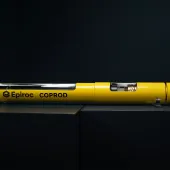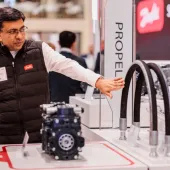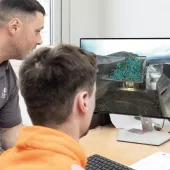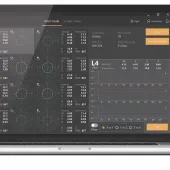Developing the Digital Quarry ‘The EPC Way’

First published in the June 2021 issue of Quarry Management
At this year’s Hillhead Digital event, EPC-UK explosives engineer Dr Liam Bermingham detailed new possibilities to digitally measure, store and analyse data throughout the entire drilling and blasting process – from surveying and design to measuring the resulting blast performance – to help implement a fully digitalized quarry operation, and explored how this, alongside mobile and fixed plant telematic systems, can significantly impact productivity, effectiveness and, most importantly, safety
The way quarry companies operate is now being transformed by digitalization, from autonomous surveying practices to pre-planning of drilling and blasting activities through to developments in business software. These enhancements in technologies are driving increased efficiencies across the whole industry. With these improvements and the implementation of technology it is possible to accurately measure, record and analyse performance data in all areas of the quarrying operation, from drilling and blasting to loading and hauling and the crushing and screening processes. Utilizing the KPIs that we record on site, we can monitor and review blast performance and the real effect it has on a quarrying operation, and by collecting such data accurately, the correct decisions can be made and implemented to reach the desired goal for a particular site.
The latest tools and technologies
At EPC-UK, we have been implementing the latest tools to fully digitalize our blasting process. We are now using drone technology with advanced photogrammetry techniques to carry out face profiling.
We have developed our own in-house advanced blast design software called Expertir. This is an integrated, highly advanced drilling and blasting software package that combines multiple streams of data, achieved using a range of technologies, including GPS, hole probing and drone photogrammetry, which together can create complex blast designs. Producing a 3D map of a site, Expertir allows our engineers to generate precise pre- and post-drill profiles together with accurate timing plans, to produce the optimum blast performance.
We carry out GPS RTK (Real Time Kinematics) surveys in conjunction with our drone surveys to improve the accuracy and use an application called Expertab to record all drilling information and to monitor and record the blasthole loading process. These data, as well as information recorded after probing holes, can be fed directly back into the Expertir software.
We can also now remotely fire a blast using electronic detonators from a safe location outside a danger zone, and perform a variety of post-blast analyses using drone technology to create 3D models of the muckpile, which can then be fed through fragmentation analysis tools.
Recording KPIs
All this key information is inputted into our online cloud-based database called Explore, from where we can look at and analyse all the data together. However, we also need to analyse the drill and blast data in conjunction with key information currently recorded on site.
Combined, these Key Performance Indicators provide an indication of blast performance; for example, improved loading times at the face suggest an improvement in fragmentation. A decrease in fuel usage by face excavators or front-end loaders also indicates improved fragmentation, as does increased crusher throughput and percentage of split materials scalped off at the primary crusher or oversize in the muckpile. Results from all these KPIs help us to make the correct decisions for future blast designs.
Safer drone implementation
Safety levels are heightened significantly across all quarry operations as a result of implementing drone technologies. Using photogrammetry techniques, the drones – which are piloted from outside the danger zone by specially trained operatives – perform face-profiling surveys comprising a series of overlapping high-resolution photographs from known locations. Together, these create an accurate 3D model of the area, which can also be geo-referenced using GPS. The benefits of face profiling using drones are manifold. First and foremost, it is safer, meeting with EPC-UK’s core value of prioritizing safety, as the profiling can be achieved from a controlled position – usually on top of the bench. Also, the whole process improves accuracy, the geological conditions can be recorded and the information imported straight into Expertir.
The drone face-profiling technique also allows us to obtain measurements from behind obstructions such as toe bunds where laser profiles can be ineffective. Thus, profiling is also faster than traditional laser-profiling surveys in situations where multiple set-ups would be required.
The resulting 3D model from the pre-profile survey using the drone is fed directly into the Expertir software package. This is used to calculate the profiles for that particular survey and, by using the inbuilt blast-design algorithms, automatic generation of blasthole locations can be achieved in order to fully optimize the energy distribution throughout that blast. Allowing us to position the holes exactly where we need them, before going to mark out or drill.
This information is directly fed on to the cloud-based Explore platform, from where it – together with all the parameters of a particular blast – can be downloaded by the driller on to the Expertab application.
Digital drill logs are generated and stored on the Explore platform, and digitally recorded drill logs are then uploaded to Expertir for the final blast design.
Once the blast has been fully designed, it is re-uploaded to Expertab and accessed by the bulk emulsion truck operator using a tablet. Via inbuilt WiFi on the MEMU (mobile explosives manufacturing unit), the tablet connects wirelessly to the bulk emulsion truck’s control system and controls and records the entire hole-loading process. This information is fed back into the Explore platform once the blast has been completed. As well as digitalizing the drilling process, we are able to digitalize the hole-loading process too.
Performance monitoring of a blast
We are now able to fully utilize drone technology to monitor and review the performance of a blast and can make use of high-resolution 4K video cameras to record it. The high-resolution video camera is a great tool for reviewing the blast, but it does not allow us to quantify its performance.
However, by applying the same surveying techniques used during the face-profiling stage, we can use a series of photographs and create a 3D model using a drone. We can import a 3D profile of the muckpile into specialist fragmentation analysis software that can calculate the size distribution present in that muckpile, generate a fragmentation curve and from that model, work out the percentage of undersize and oversize created by the blast.
All this information can be uploaded to the Explore platform to help generate blasting KPIs and to allow full analysis of a range of blasting parameters and their effect on resulting performance. By centralizing the blast performance data, we can analyse it as a whole and not in isolation, allowing for more efficient decision-making in the future.
Whilst the technology presents us with the ability to quantify blast performance, to determine the real effect of the blast on a quarrying operation, we need to look at the data in conjunction with KPIs recorded throughout various stages of the quarrying process. Other site performance data required includes loading and hauling data and crushing and screening data, as these two processes are directly affected by the drilling and blasting operation.
In terms of the load and haul process, measuring KPIs can provide a true indication of a blast’s performance. Such KPIs include, but are not limited to, loading times at the face, payload distribution, fuel usage, machine usage, secondary breaking, and the repair and maintenance costs of a load and haul fleet.
In addition to the load and haul performance, we need to analyse the site’s processing plant performance. The KPIs associated with this phase of a quarrying process are more commonly recorded and include primary crusher throughput, energy consumption of the primary crusher and percentage of scalpings.
By looking at all this information combined, it is possible to quantify the true impact of the drill and blast phase on the actual cost of the quarrying operation and identify the improvements that can be made.
The Digital Quarry Project illustrates how recording and analysing all this data together can benefit a quarrying operation and its running efficiency. ‘The EPC Way’ Digital Quarry Project, is a programme created by EPC-UK in 2018 with the aim of implementing and developing the latest technologies and applying them to a live UK quarry. This project has allowed us to realize the possible benefits, not just to the drill and blast process, but also to the overall quarry operation and its performance.
After implementing drone and GPS surveying technologies, GPS-navigated smart drill rigs, staggered patterns and auto hole layout generated using Expertir, data showed that the power consumption of the primary crusher reduced by 0.13kWh per tonne (850MWh per annum) and scalpings reduced by 5.7% – materials that could be retained at the primary crusher. We also saw an improvement in the product split with an 11.5% increase going through the primary crusher – so fewer scalpings and less oversize.
Overall, the results have shown an improvement in blast fragmentation which has led to a ‘tightening’ of the particle size distribution curve, as well as higher throughput and a lower percentage of waste material.
It truly shows the benefits that can be achieved by accurately recording, measuring and analysing all relevant data, ie not just drill and blast data, but load and haul, processing and plant data together.
Conclusion
It is now possible to fully digitize the blasting process using the latest technology. By accurately measuring and analysing blast performance using drone technology, data recorded by mobile plant telematic systems or other load and haul KPIs and performance data related to the mineral processing phase, such as primary crusher performance data, significant improvements can be achieved.
We are able to fully quantify blast performance and its impact on the entire quarrying operation and we can make informed decisions for future blast designs – thereby optimizing the entire rock-breaking process for a quarrying operation.
About the author
Dr Liam Bermingham is a graduate of the University of Leeds and has completed a degree in Mining Engineering and a PhD in The Prediction and Control of Air Overpressure that Arises as a Result of Quarry Blasting. During this period, he co-wrote and presented several published technical papers for international drilling and blasting journals and conferences. He then worked for three years as a blasting consultant specializing in the environmental impacts of blasting, before gaining valuable practical experience working in quarry operations in roles including shotfirer and operations management. He joined EPC-UK in 2019 and has been working in his current role as explosives engineer since 2020.
- Subscribe to Quarry Management, the monthly journal for the mineral products industry, to read articles before they appear on Agg-Net.com








